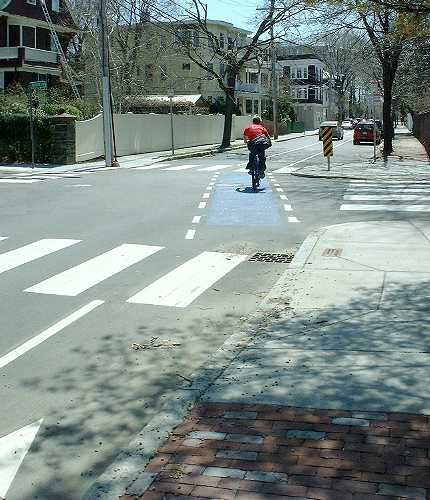
Top: Home Page
Up: Cambridge bicycle facilities and program
Previous:
Next:
SPARKS STREET, CAMBRIDGE:
|
Sparks Street at Foster Street, Cambridge, Massachusetts,
USA --
Bike lane jogs left, motorists don't.

| The traffic law requires drivers to merge to the right curb before turning. However,
as the photo below shows, a solid white bike lane line extends up to the crosswalk before
the intersection, and the bike lane has dashed borders only inside the intersection,
directing motorists to turn right from the left lane. The bike lane also directs
bicyclists to swerve left. A knowledgeable bicyclist would merge left before the
intersection in order to establish right of way and avoid conflict with right-turning
motorists. Now, that would slow overtaking motorists. But the premise of traffic
calming is to constrict vehicle movement in order to slow traffic -- rather than to allow
the normal interaction of vehicles on the road to slow the traffic. How might motorists be made to jog left? A barrier between the bike lane and the rest of the street would accomplish that, but it would constrain bicyclists to enter the bike lane in the door zone after the intersection, and would interfere with turning movements by large vehicles. |
Bicyclist directed to swerve across path of right-turning
motor traffic.
Photos taken April 14, 2005

Lessons of this design:
|
Top: Home Page
Up: Cambridge bicycle facilities and program
Previous:
Next: